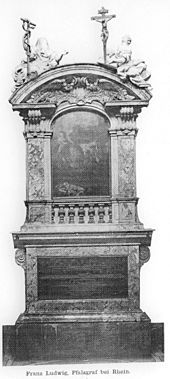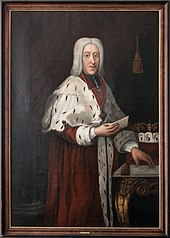Franz Ludwig of Pfalz-Neuburg
Franz Ludwig von Pfalz-Neuburg (born July 24, 1664 in Neuburg an der Donau , † April 18, 1732 in Breslau ) was Prince-Bishop and Supreme Governor of Breslau and at the same time Elector and Archbishop of Trier , Elector and Archbishop of Mainz and Bishop of Worms as well as Grand Master of the Teutonic Order , Prince Propst von Ellwangen and Imperial Arch Chancellor of the Holy Roman Empire of the German Nation . His sister Eleonore (1655-1720) was the wife of Emperor Leopold .
Life
Origin and youth
Franz Ludwig was born the ninth of seventeen children of Elector Philipp Wilhelm von der Pfalz and Elisabeth Amalie Magdalena von Hessen-Darmstadt . He was a brother of the Palatinate Electors Johann Wilhelm (1658-1716) and Karl III. Philipp (1661–1742), as well as the prince-bishop of Augsburg, Alexander Sigismund von Pfalz-Neuburg (1663–1737). His eldest sister Eleonore von Pfalz-Neuburg was the wife of Emperor Leopold I and the mother of the later Emperors Joseph I and Karl VI. Other sisters became queens of Spain and Portugal.
His humanistic upbringing was shaped by the Brothers of Mercy and the Jesuits at his father's court in Düsseldorf and Neuburg. At the age of 14 he received a canonical in Olomouc , and a year later in Münster , Speyer and Strasbourg . He had never been ordained a priest. Other high church offices followed:
Prince-Bishop of Wroclaw
Franz Ludwig's brother Wolfgang Georg Friedrich was actually intended for this office, but he died before the election. With the support of the Viennese court - Franz Ludwig's sister Eleonore Magdalene was the third wife of Emperor Leopold I - he was elected Prince-Bishop of Breslau in 1683, which was to become the center of his life. Just two years later he became the imperial governor of Silesia , which gave him the highest spiritual and secular power for decades. In 1687 took place the Subdiakonatsweihe . In 1694 he carried out a reorganization of the seminary for the Principality of Wroclaw, founded the University of Wroclaw "Leopoldina" in 1702 , the Hospital of the Brothers of Mercy in 1711 and in 1702 the electoral orphanage "Orphanotropheum". In Neisse he had the Kreuzherrenstift and in 1729 the new building of the episcopal residence built. In Ottmachau , the dilapidated parish church of St. Nicholas was demolished under his rule, a new baroque church was built and the so-called lower castle was built in 1706–1707.
Bishop of Worms
As the successor to his brother Ludwig Anton von Pfalz-Neuburg , who died in 1694 , he became Bishop of Worms. Among other things, he initiated the restoration of the Worms Cathedral and founded an orphanage. He also retained this office until the end of his life.
Grand Master of the Teutonic Order
He also received the office of Grand Master in 1694, succeeding his brother Ludwig Anton. He initiated the reorganization of the order and fought against the unlawful elevation of the Elector of Brandenburg to King of Prussia , which was a fiefdom of the Teutonic Order. In the position of Grand Master, Franz Ludwig donated the imperial infantry regiment "Pfalz-Neuburg-Teutschmeister" and had the Teutonic Order House in Mainz built in baroque form in 1730 . Although head of the order, he never made profession .
Prince Provost of Ellwangen
Here, too, he succeeded his late brother Ludwig Anton in 1694. He carried out a judicial reform, initiated new forest and hunting regulations and renewed the court council regulations. 1702–1729 the Jesuit College and the Jesuit Church were built. 1709–1729 the pilgrimage church was rebuilt on the Schönenberg , which was burned out in 1709 after a lightning strike.
Archbishop of Trier
1716–1729 he held the office of elector and archbishop of Trier and in particular ordered the jurisdiction of the diocese. Under his rule, the destroyed Trier was rebuilt, the Moselle bridge was built and the Trier cathedral was given a baroque style .
Archbishop of Mainz
After Franz Ludwig had already been appointed coadjutor of the Imperial Arch Chancellor Foundation in Mainz in 1710 , he became Elector and Archbishop of Mainz in 1729, succeeding Lothar Franz von Schönborn, and thus also Arch Chancellor and thus the highest dignitary of the empire after the Emperor. Since combining both electoral offices in one hand violated imperial law, he had to give up an electoral archbishopric; Franz-Ludwig decided against Trier and for the more prestigious Mainz. In Mainz, too, he began reforms in the administrative and legal areas.

After returning from a trip to Vienna, Franz Ludwig died surprisingly on April 18, 1732 in Breslau. As early as 1716 to 1724 he had the Elector's Chapel built as his mausoleum at the Breslau Cathedral according to plans by Johann Bernhard Fischer von Erlach , in which he was buried.
coat of arms
The splendid coat of arms of Franz Ludwig von der Pfalz-Neuburg impressively document the extent of his territorial possessions.
meaning
Although he - while holding five ecclesiastical dignities - received no higher orders, Franz Ludwig was one of the most important personalities of the imperial church of the early 18th century. He initiated numerous administrative and legal reforms in all areas in which he was in charge, fought for the interests of the church and supported the counter-reformation measures. In 1724 he participated in the Wittelsbach House Union . He was also a great art patron.
ancestors
| Philipp Ludwig (Pfalz-Neuburg) (1547-1614) | |||||||||||||
| Wolfgang Wilhelm (Pfalz-Neuburg) (1578–1653) | |||||||||||||
| Anna von Jülich-Kleve-Berg (1552–1632) | |||||||||||||
| Philipp Wilhelm (Palatinate) (1615–1690) | |||||||||||||
| Wilhelm V (Bavaria) (1548–1626) | |||||||||||||
| Magdalene of Bavaria (1587–1628) | |||||||||||||
| Renata of Lorraine (1544–1602) | |||||||||||||
| Franz Ludwig of Pfalz-Neuburg | |||||||||||||
| Ludwig V (Hessen-Darmstadt) (1577–1626) | |||||||||||||
| George II (Hessen-Darmstadt) (1605–1661) | |||||||||||||
| Magdalena of Brandenburg (1582–1616) | |||||||||||||
| Elisabeth Amalia of Hessen-Darmstadt (1635–1709) | |||||||||||||
| Johann Georg I (Saxony) (1585–1656) | |||||||||||||
| Sophie Eleonore of Saxony (1609–1671) | |||||||||||||
| Magdalena Sibylle of Prussia (1586–1659) | |||||||||||||
literature
- Leopold von Eltester : Franz Ludwig . In: Allgemeine Deutsche Biographie (ADB). Volume 7, Duncker & Humblot, Leipzig 1877, p. 307 f.
- Anton Brück: Franz Ludwig, Count Palatine of Neuburg. In: New German Biography (NDB). Volume 5, Duncker & Humblot, Berlin 1961, ISBN 3-428-00186-9 , p. 369 f. ( Digitized version ).
- Karl Kastner: Wroclaw Bishops . East German publishing company, Breslau 1929.
- Friedrich Maria Illert: Prince-Bishop Franz Ludwig, the renewer of the diocese of Worms. In his memory on the 200th anniversary of his death . In: Der Wormsgau 1, 1926/33, pp. 340–343
- Josef Johannes Schmid : Franz Ludwig von Pfalz-Neuburg. In: Biographisch-Bibliographisches Kirchenlexikon (BBKL). Volume 16, Bautz, Herzberg 1999, ISBN 3-88309-079-4 , Sp. 1231-1237.
Web links
- Entry on Franz Ludwig von Pfalz-Neuburg on catholic-hierarchy.org
- Comprehensive private website on Franz Ludwig
- PDF biography
- Franz Ludwig von Pfalz-Neuburg in the Saarland biographies
Individual evidence
| personal data | |
|---|---|
| SURNAME | Franz Ludwig of Pfalz-Neuburg |
| ALTERNATIVE NAMES | Franz Ludwig of the Palatinate |
| BRIEF DESCRIPTION | Prince-Bishop of Breslau; Bishop of Worms; Archbishop of Mainz; Archbishop of Trier; Grand Master of the Teutonic Order |
| DATE OF BIRTH | July 24, 1664 |
| PLACE OF BIRTH | Neuburg on the Danube |
| DATE OF DEATH | April 18, 1732 |
| Place of death | Wroclaw |






